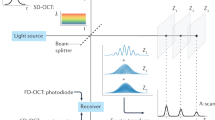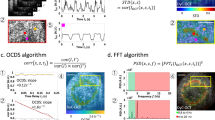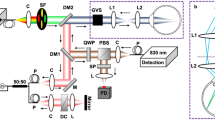Abstract
Molecular imaging holds a pivotal role in medicine due to its ability to provide invaluable insight into disease mechanisms at molecular and cellular levels. To this end, various techniques have been developed for molecular imaging, each with its own advantages and disadvantages1,2,3,4. For example, fluorescence imaging achieves micrometre-scale resolution, but has low penetration depths and is mostly limited to exogenous agents. Here, we demonstrate molecular imaging of endogenous and exogenous chromophores using a novel form of spectroscopic optical coherence tomography. Our approach consists of using a wide spectral bandwidth laser source centred in the visible spectrum, thereby allowing facile assessment of haemoglobin oxygen levels, providing contrast from readily available absorbers, and enabling true-colour representation of samples. This approach provides high spectral fidelity while imaging at the micrometre scale in three dimensions. Molecular imaging true-colour spectroscopic optical coherence tomography (METRiCS OCT) has significant implications for many biomedical applications including ophthalmology, early cancer detection, and understanding fundamental disease mechanisms such as hypoxia and angiogenesis.
This is a preview of subscription content, access via your institution
Access options
Subscribe to this journal
Receive 12 print issues and online access
$209.00 per year
only $17.42 per issue
Buy this article
- Purchase on Springer Link
- Instant access to full article PDF
Prices may be subject to local taxes which are calculated during checkout





Similar content being viewed by others
References
Ntziachristos, V., Tung, C. H., Bremer, C. & Weissleder, R. Fluorescence molecular tomography resolves protease activity in vivo. Nature Med. 8, 757–761 (2002).
Wang, X. et al. Noninvasive laser-induced photoacoustic tomography for structural and functional in vivo imaging of the brain. Nature Biotechnol. 21, 803–806 (2003).
Helmchen, F. & Denk, W. Deep tissue two-photon microscopy. Nature Methods 2, 932–940 (2005).
Boppart, S. A., Oldenburg, A. L., Xu, C. & Marks, D. L. Optical probes and techniques for molecular contrast enhancement in coherence imaging. J. Biomed. Opt. 10, 041208 (2005).
Huang, D. et al. Optical coherence tomography. Science 254, 1178–1181 (1991).
Morgner, U. et al. Spectroscopic optical coherence tomography. Opt. Lett. 25, 111–113 (2000).
Yi, J., Gong, J. & Li, X. Analyzing absorption and scattering spectra of micro-scale structures with spectroscopic optical coherence tomography. Opt. Express 17, 13157–13167 (2009).
Cang, H. et al. Gold nanocages as contrast agents for spectroscopic optical coherence tomography. Opt. Lett. 30, 3048–3050 (2005).
Oldenburg, A. L., Hansen, M. N., Ralston, T. S., Wei, A. & Boppart, S. A. Imaging gold nanorods in excised human breast carcinoma by spectroscopic optical coherence tomography. J. Mater. Chem. 19, 6407–6411 (2009).
Faber, D. J., Mik, E. G., Aalders, M. C. G. & van Leeuwen, T. G. Toward assessment of blood oxygen saturation by spectroscopic optical coherence tomography. Opt. Lett. 30, 1015–1017 (2005).
Faber, D. J. & van Leeuwen, T. G. Are quantitative attenuation measurements of blood by optical coherence tomography feasible? Opt. Lett. 34, 1435–1437 (2009).
Yi, J. & Li, X. Estimation of oxygen saturation from erythrocytes by high-resolution spectroscopic optical coherence tomography. Opt. Lett. 35, 2094–2096 (2010).
Graf, R. N. & Wax, A. Temporal coherence and time-frequency distributions in spectroscopic optical coherence tomography. J. Opt. Soc. Am. A 24, 2186–2195 (2007).
Xu, C., Kamalabadi, F. & Boppart, S. A. Comparative performance analysis of time–frequency distributions for spectroscopic optical coherence tomography. Appl. Opt. 44, 1813–1822 (2005).
Cohen, L. Time-frequency distributions—a review. Proc. IEEE 77, 941–981 (1989).
Robles, F., Graf, R. N. & Wax, A. Dual window method for processing spectroscopic optical coherence tomography signals with simultaneously high spectral and temporal resolution. Opt. Express 17, 6799–6812 (2009).
Grajciar, B., Pircher, M., Fercher, A. F. & Leitgeb, R. A. Parallel Fourier domain optical coherence tomography for in vivo measurement of the human eye. Opt. Express 13, 1131–1137 (2005).
Graf, R. N., Brown, W. J. & Wax, A. Parallel frequency-domain optical coherence tomography scatter-mode imaging of the hamster cheek pouch using a thermal light source. Opt. Lett. 33, 1285–1287 (2009).
Huang, Q. et al. Noninvasive visualization of tumors in rodent dorsal skin window chambers. Nature Biotechnol. 17, 1033–1035 (1999).
Koehl, G. E., Gaumann, A. & Geissler, E. K. Intravital microscopy of tumor angiogenesis and regression in the dorsal skin fold chamber: mechanistic insights and preclinical testing of therapeutic strategies. Clin. Exp. Metastasis 26, 329–344 (2009).
Robles, F. E., Chowdhury, S. & Wax, A. Assessing hemoglobin concentration using spectroscopic optical coherence tomography for feasibility of tissue diagnostics. Biomed. Opt. Express 1, 310–317 (2010).
Skala, M. C., Fontanella, A., Lan, L., Izatt, J. A. & Dewhirst, M. W. Longitudinal optical imaging of tumor metabolism and hemodynamics. J. Biomed. Opt. 15, 011112 (2010).
Acknowledgements
This research was supported by a grant from the National Institutes of Health (NCI 1 R01 CA138594-01).
Author information
Authors and Affiliations
Contributions
F.E.R. conducted the optical experiments and analysed the data. C.W. and G.G. procured the animal model and carried out animal protocols. F.E.R. and A.W. contributed to the genesis of the idea and wrote the paper.
Corresponding author
Ethics declarations
Competing interests
A.W. is the founder and chairman of Oncoscope, which licenses the rights to intellectual property underlying this work.
Supplementary information
Supplementary information
Supplementary information (PDF 558 kb)
Supplementary information
Supplementary Movie (MOV 8094 kb)
Supplementary information
Supplementary Movie (MOV 7968 kb)
Rights and permissions
About this article
Cite this article
Robles, F., Wilson, C., Grant, G. et al. Molecular imaging true-colour spectroscopic optical coherence tomography. Nature Photon 5, 744–747 (2011). https://doi.org/10.1038/nphoton.2011.257
Received:
Accepted:
Published:
Issue Date:
DOI: https://doi.org/10.1038/nphoton.2011.257
This article is cited by
-
Accessing depth-resolved high spatial frequency content from the optical coherence tomography signal
Scientific Reports (2021)
-
Optical density based quantification of total haemoglobin concentrations with spectroscopic optical coherence tomography
Scientific Reports (2021)
-
Wolf phase tomography (WPT) of transparent structures using partially coherent illumination
Light: Science & Applications (2020)
-
Spectral contrast optical coherence tomography angiography enables single-scan vessel imaging
Light: Science & Applications (2019)
-
Real-time high-resolution mid-infrared optical coherence tomography
Light: Science & Applications (2019)



